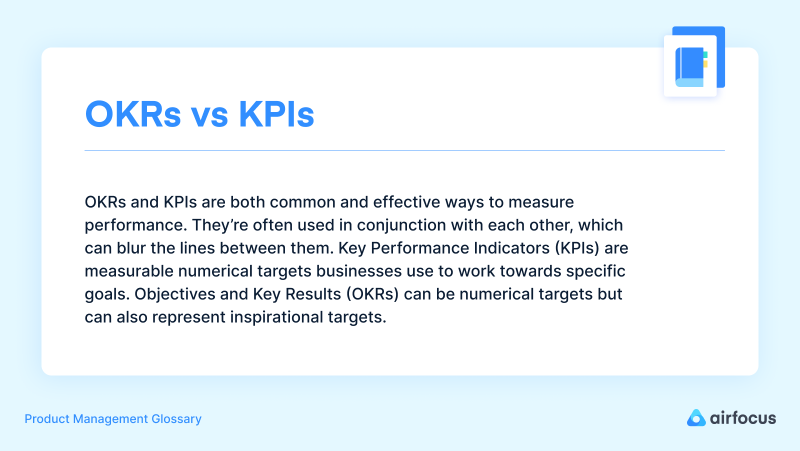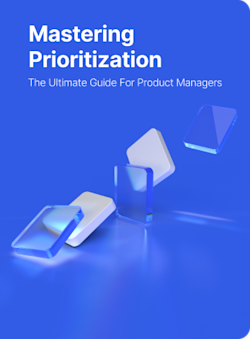OKRs vs KPIs
OKRs vs. KPIs: What’s the difference?
OKRs vs KPIs
OKRs and KPIs are both common and effective ways to measure performance. They’re often used in conjunction with each other, which can blur the lines between them. Key Performance Indicators (KPIs) are measurable numerical targets businesses use to work towards specific goals. Objectives and Key Results (OKRs) can be numerical targets but can also represent inspirational targets.
Let’s dive a little deeper into OKRs, KPIs, and their differences.
What are OKRs?
Objectives and Key Results are a way to measurably align individual performance with overall goals.
It’s a reliable way to boost your team’s efforts and ensure long-term goals are met.
A well-defined OKR will include an objective, which is your overall goal, and one or more key results that you will use to identify when you have achieved that goal.
It’s best to use OKRs when your company wants to achieve expansive growth, energize complacent teams when KPIs aren’t working, or when you have other ambition-based goals.
What are KPIs?
A Key Performance Indicator is a measurable value that aligns directly with an overall goal or business objective. The KPIs you use will vary depending on your goals. You need to choose KPIs that will support long-term goals, whether you’re working with a small team or working towards objectives that affect the entire business.
Well-defined KPIs should be quantifiable using real-world metrics like percentages or a target number. They should be clearly linked to the overall goals of your business and be simple enough to be understood by anyone in or outside of your business.
KPIs are best used when a business has a clearly defined and measurable goal. This can include staying the course, verifying business sustainability, or even measuring past performance.
Can OKRs and KPIs be combined?
Absolutely! The majority of the confusion between OKRs are KPIs stems from their ability to be combined.
Both measurements have a different focus and can give you a much more accurate indication of success when used together.
Examples of OKRs and KPIs
The simplest way to understand the difference between OKRs and KPIs is by looking at examples of when each is used. Here are some common examples of when to use OKRs and when to use KPIs.
Examples of KPIs
Number of new subscribers per period
Growth in revenue
Percentage of market share
Time to market
Employee satisfaction
Monthly website traffic
Conversion rate
Examples of OKRs
Objective: Improve our sales performance
Key result: Increase conversion rate from 20% to 25%*
Key result: Improve follow-up communication with leads
Objective: Increase brand awareness in new markets
Key result: Increase web traffic in target markets by 15%*
Key result: Increase newsletter signups by 25%*
*These key results can also be used as KPIs.
Tips and best practices for setting OKRs and KPIs in product management
Set SMART goals
SMART goals are goals that are Specific, Measurable, Attainable, Relevant, and Time-Bound. SMART goals ensure that all metrics are clear, focused, precise, and easy to understand.
Don't try to track everything
It’s worth remembering that the K in OKR and KPI stands for “Key.” This is important because you could spend months chasing KPIs and OKRs that don’t add any value to your business. Only try to track things that actually matter.
Regularly review your OKRs and KPIs
Product management is a rapidly changing area, and you should review your goals regularly to ensure they’re still relevant and add value.
Examples of OKRs and KPIs in different industries
Organizations across various industries can (and do) use OKRs and KPIs. However, according to markets, target demographics, and other essential factors, they can differ significantly from one industry to the next.
To illustrate these differences, here are OKR vs KPI examples across five industries.
1. Manufacturing
A common OKR in manufacturing may be to reduce production costs, say by 10 - 15%. This can help companies get a better return on investment and free up funds for other areas.
Key results for this objective could be:
Negotiate with existing material suppliers to bring down costs by 5 to 10% or find cost-effective alternatives.
Explore energy-efficient options to reduce avoidable expenses in production areas.
A KPI in manufacturing might be:
Cost per unit manufactured
2. Healthcare
An OKR in healthcare could be to provide patients with a more satisfying experience. That can increase their likelihood of returning when necessary and becoming an advocate.
Key results for this objective could be:
Boost satisfaction scores among patients by 10%.
Reduce wait times by 15%.
A similar KPI in healthcare might be:
Duration of patient’s average stay
3. Human resources
A great OKR in human resources would be to boost engagement rates among employees within the next six months. Employees may become more productive and motivated to work at their best when they feel more engaged.
Key results for this objective could be:
Survey employees regularly (e.g. monthly) for suggestions on improving the workplace. Use anonymity to promote honesty and peace of mind.
Introduce a reward scheme for hitting realistic targets.
A similar KPI in human resources might be:
Employee general satisfaction rates
4. Education
A great OKR for educational institutions would be to improve technological infrastructure for students across the school/college.
Key results for this objective could be:
Upgrade computer facilities for 25% of departments by the end of year.
Survey 80% of students on ideas for technology investments by the end of year.
Meanwhile, a KPI for the education industry could be:
Cost per graduate
5. Insurance
Enhancing claims processing speed for a better client experience is a great OKR for the insurance industry.
Key results for this objective could be:
Reduce average claim settlement time from 72 hours to 48 hours.
Increase average client satisfaction scores by 10%.
A good KPI for an insurance company could be:

General FAQ

Glossary categories
Prioritize with confidence

Experience the new way of doing product management








